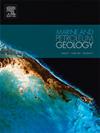Development model of fracture-filling gas hydrates at the top of gas chimneys, the Songnan Low Uplift in Qiongdongnan Basin of the northern South China Sea
IF 3.7
2区 地球科学
Q1 GEOSCIENCES, MULTIDISCIPLINARY
引用次数: 0
Abstract
Fracture-filling gas hydrates are consistently associated with gas chimneys; however, the causal mechanism remains unclear. The W07 orebody in the Songnan Low Uplift, located in the Qiongdongnan Basin of the northern South China Sea, was examined as a case study. By employing a combination of logging while drilling and seismic surveys, we aimed to elucidate the developmental model of fracture-filling gas hydrates within the structural context of gas chimneys and quantitatively assess the roles of the overlying strata and faults in the formation of leakage pathways. Gas of various origins migrates to the bottom of the gas hydrate stability zone through the gas chimney and subsequently flows laterally within the permeable sand strata. Pore-filling gas hydrates develop in the peripheral areas surrounding the gas chimney. The continuous accumulation of free gas in the central area leads to an increase in fluid pressure. Once the fluid pressure reaches the horizontal minimum principal stress, the overlying strata will undergo hydraulic fracturing, leading to the formation of a network of vertical hydraulic fractures that provide a pathway for the further upward migration of gas-bearing fluids. Fracture-filling gas hydrates form in high-angle cracks under appropriate temperature and pressure conditions. In terms of leakage, the overlying strata, with a minimum hydraulic pressure of 1.08 MPa, take precedence over the F07 fault, which has a minimum increment in fluid pressure of 1.12 MPa. Thus, the overlying strata, rather than the F07 fault, play a decisive role in the formation of leakage pathways.
求助全文
约1分钟内获得全文
求助全文
来源期刊

Marine and Petroleum Geology
地学-地球科学综合
CiteScore
8.80
自引率
14.30%
发文量
475
审稿时长
63 days
期刊介绍:
Marine and Petroleum Geology is the pre-eminent international forum for the exchange of multidisciplinary concepts, interpretations and techniques for all concerned with marine and petroleum geology in industry, government and academia. Rapid bimonthly publication allows early communications of papers or short communications to the geoscience community.
Marine and Petroleum Geology is essential reading for geologists, geophysicists and explorationists in industry, government and academia working in the following areas: marine geology; basin analysis and evaluation; organic geochemistry; reserve/resource estimation; seismic stratigraphy; thermal models of basic evolution; sedimentary geology; continental margins; geophysical interpretation; structural geology/tectonics; formation evaluation techniques; well logging.
 求助内容:
求助内容: 应助结果提醒方式:
应助结果提醒方式:


